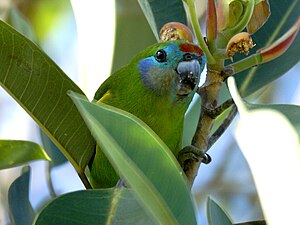Masked dwarf parrot
| Masked dwarf parrot | ||||||||||
|---|---|---|---|---|---|---|---|---|---|---|

Masked dwarf parrot, female |
||||||||||
| Systematics | ||||||||||
|
||||||||||
| Scientific name | ||||||||||
| Cyclopsitta diophthalma | ||||||||||
| ( Hombron & Jacquinot , 1841) |
The masked dwarf parrot ( Cyclopsitta diophthalma ) is a species of parrot that is common in the Australasian region. It mainly inhabits forests on New Guinea and neighboring islands, but also occurs on the tropical northeast coast of Australia. With a body length of 13 centimeters, it is the smallest parrot found in Australia.
Eight subspecies are distinguished. There are three subspecies in Australia, all of which have sex dimorphism . The males usually have a larger area of red feathers on their faces than the females.
The species is classified as not endangered overall by the IUCN . However, the status of some subspecies is less positive. The blue- cheeked masked parrot ( C. d. Coxeni ) is one of Australia's rarest birds. It has been sighted less than 200 times since John Gould first described it in 1866. It is strictly protected in Australia. Little is known about the way of life of the masked parrots because they are difficult to observe. They stay in the foliage of rainforest trees and are difficult to spot because of their plumage.
description
Masked dwarf parrots reach a body length of 13 centimeters and weigh between 25 and 41 grams.
Males of the nominate form have strong green plumage. The underside of the body is a little more yellow. The forehead, reins, parting, cheeks and ear covers are bright red. A yellow band runs behind the red plumage of the crown of the head. There is a blue-greenish spot above and below the eye. There is a light purple band below the red cheek plumage. The flanks and the side chest are bright yellow. The tail is dark green. The beak is light gray at its base and dark gray towards the tip. The iris is dark brown. The legs are greenish-gray.
The females of the nominate form lack red head sections. The front part of the head is purple-blue and bordered by a narrow, lighter band. The individual subspecies differ from the nominate form mainly in the color division of the face mask.
The flight of the masked dwarf parrots is quick and straightforward. They usually fly high above the canopy of the rainforest. They avoid flying through tree tops. During the flight, a sharp, piercing tsiet can be heard as a contact call. The warning call is shrill and very loud.
behavior
The masked parrot almost exclusively eats seeds of ripe and almost ripe figs . A number of fruits from both native and imported or cultivated plants play a lesser role in their diet. They also ingest nectar and pollen. Most likely, they also eat insects and their larvae. The food is usually consumed in pairs or in small groups of a few individuals.
Unlike most parrots, the masked parrot digs its own den. It uses decaying tree stumps and dead branches to create a cave. The breeding season in Australia falls between August and November. There are only a few observations on reproductive behavior in the field. From observations on birds kept in human care, it is known that digging the nest hole is essential in order for the female to breed. The clutch consists of two eggs that are laid 48 hours apart. It only breeds the female. Young birds leave the nest at around 50 days of life.
Subspecies
The following subspecies are distinguished for the masked dwarf parrot
- Cyclopsitta diophthalma diophthalma
- Cyclopsitta diophthalma coccineifrons
- Cyclopsitta diophthalma aruensis
- Cyclopsitta diophthalma virago
- Cyclopsitta diophthalma inseparabilis
- Marshall's Masked Parrot ( Cyclopsitta diophthalma marshalli )
- Diadem-Masked Parrot Cyclopsitta diophthalma macleayana
- Blue-cheeked masked parrot Cyclopsitta diophthalma coxeni
The first five named subspecies occur in New Guinea and the neighboring islands. The last three are restricted to Australia in their range. These each colonize one of the three larger areas with subtropical or tropical rainforests.
supporting documents
Individual evidence
- ^ Forshaw, p. 314
- ^ Forshaw, p. 316
- ^ Forshaw, p. 316
- ^ Forshaw, p. 321
- ^ Forshaw, p. 321
- ^ Forshaw, p. 326
- ^ Forshaw, p. 318
literature
- Joseph M. Forshaw : Australian Parrots. 1st German-language edition. Volume 2, Arndt-Verlag, Bretten 2003, ISBN 3-9808245-2-7 .
Web link
- Cyclopsitta diophthalma inthe IUCN 2013 Red List of Threatened Species . Listed by: BirdLife International, 2012. Retrieved December 26, 2013.

